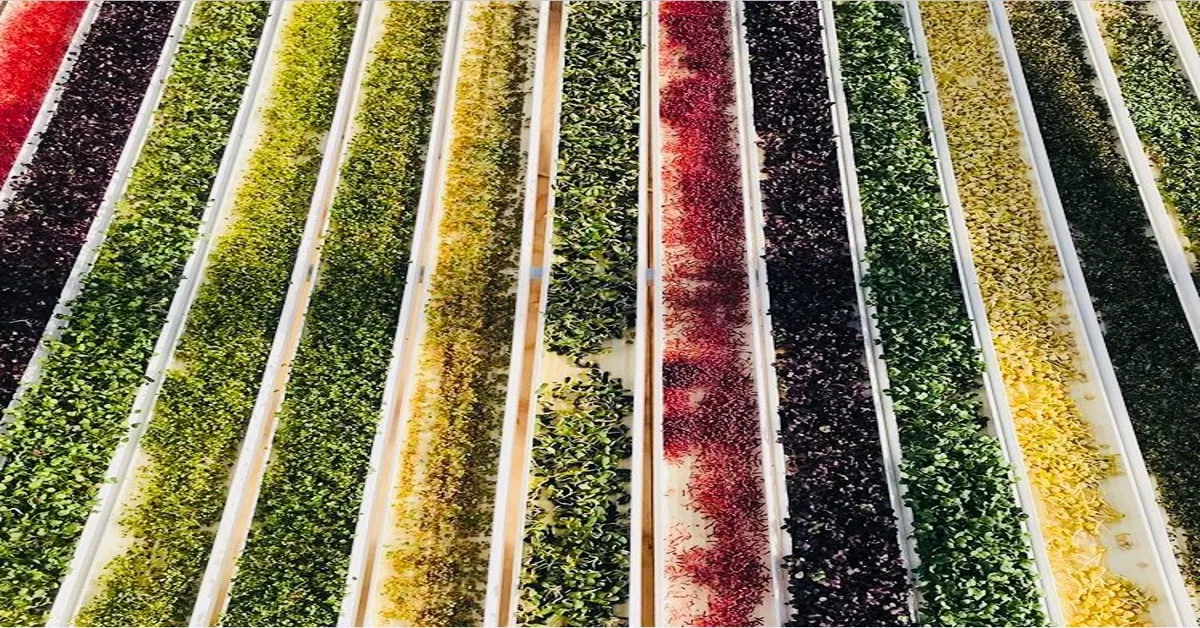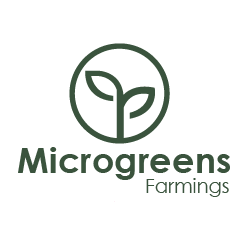**Revolutionize your city living experience** with the green, vibrant charm of *microgreen urban farming*. **Transform your concrete jungles** into lush, nutrient-rich oases. Picture your tiny balcony or windowsill blooming with an array of microgreens, offering not just a feast for the eyes but a sustainable solution to city living.
This isn’t a lofty dream, but an achievable reality, thanks to the rising trend of urban agriculture. Microgreen urban farming is leading this green revolution, proving that you don’t need sprawling acres to grow your food. Dive into this blog and discover how you can reap the nutritional and environmental benefits of growing microgreens right in the heart of the city.
Key Takeaway
- Microgreen urban farming is a rising trend in urban agriculture that allows city dwellers to grow their own food in small spaces such as balconies or windowsills.
- These mini gardens offer both aesthetic and nutritional benefits, turning concrete spaces into vibrant, green oases.
- Microgreens are nutrient-rich, making this style of farming a sustainable solution to city living and a great way to improve dietary health.
- Beyond personal benefits, microgreen urban farming also contributes to environmental sustainability by reducing the need for transportation of food, thereby reducing carbon emissions.
- The article encourages readers to get involved in microgreen urban farming, highlighting its accessibility and the potential benefits to personal health and the environment.
What are Microgreens?
Embracing Microgreen Urban Farming The concept of microgreen urban farming is revolutionizing the agricultural landscape. It involves the cultivation of nutritious, quick-to-harvest microgreens in urban areas, utilizing space efficiently. This innovative method of farming not only addresses food scarcity but also promotes sustainable living.
Microgreens, despite their small size, are packed with essential nutrients, making them a vital component of a healthy diet. The adoption of microgreen urban farming is transforming concrete jungles into lush, green food factories. The beauty of this farming technique is its simplicity and adaptability, making it feasible for everyone, irrespective of their farming expertise.
Embrace microgreen urban farming and contribute to a healthier and greener planet.
microgreen urban farming
| Microgreen Type | Growing Conditions | Harvesting Time |
| Arugula: This fast-growing variety is known for its peppery flavor. | Arugula prefers cooler temperatures and can tolerate partial shade. | Arugula is ready to harvest in about 7-10 days after germination. |
| Radish: This microgreen offers a spicy, crisp taste to salads and dishes. | Radish microgreens require plenty of sunlight and moderate temperatures. | Radish microgreens can be harvested in around 10-12 days. |
| Broccoli: Known for its health benefits, it provides a mild flavor. | Broccoli microgreens prefer cooler temperatures and partial sunlight. | Broccoli microgreens are ready to harvest in about 10-14 days. |
| Beetroot: These microgreens have a sweet and earthy flavor. | Beetroot microgreens require moderate temperatures and plenty of sunlight. | Beetroot microgreens can be harvested in around 10-12 days. |
| Pea Shoots: These microgreens are sweet and crunchy, perfect for salads. | Pea shoots prefer cooler temperatures and can grow in partial shade. | Pea shoots are ready to harvest in about 10-14 days. |

The Rise of Urban Farming
The Evolution of Microgreen Urban Farming The buzzword in sustainable urban living today is microgreen urban farming. Born out of the need for fresh, nutrient-rich produce, this innovative farming method has taken the urban world by storm. Microgreen urban farming is a revolutionary approach to growing your own food right in your urban backyard.
It maximizes space utilization, promotes healthy eating, and reduces the carbon footprint. By nurturing these tiny, edible greens, you are doing a favor not just for your health, but also for the environment. This is the future of urban farming – compact, productive, and sustainable.
Join the movement and start the green revolution right at your home.
Microgreen Urban Farming: A Perfect Blend
Microgreen Urban Farming: The Future of Agriculture Microgreen urban farming is revolutionizing the way we grow and consume food, particularly in densely populated cities. This innovative practice involves growing nutrient-rich microgreens in small, urban spaces, thereby reducing the need for large-scale, traditional farms. The concept of urban farming is not new, but the application of it to microgreens is a refreshing take on sustainable agriculture.
The benefits are numerous, from reducing carbon emissions to improving food security and promoting healthier diets. Microgreen urban farming is undoubtedly a game-changer, demonstrating that we can cultivate our own food, even in concrete jungles.
Challenges of Microgreen Urban Farming
Microgreen Urban Farming: The Future of Sustainable Agriculture In the context of increasing urbanization and environmental concerns, microgreen urban farming emerges as a viable solution. This innovative approach to agriculture turns city dwellers into urban farmers, cultivating tiny, nutrient-packed plants known as microgreens right in their apartments or on their rooftops. The process not only reduces the carbon footprint associated with traditional farming but also promotes local food production and healthy eating habits.
Moreover, it empowers individuals to contribute to food security in their communities, thereby fostering a sense of responsibility and connection with nature. Hence, microgreen urban farming is not just a trend, it’s a lifestyle shift towards sustainable living.
Success Stories of Microgreen Urban Farming
Microgreen Urban Farming: A Green Revolution in the Concrete Jungle Amidst the concrete jungle, a green revolution is sprouting, bringing fresh, nutritious produce to urbanites. This innovative approach is none other than Microgreen Urban Farming. It’s a sustainable agricultural practice that utilizes small spaces effectively, promoting a healthier lifestyle and contributing to the environment.
Emphasizing on the growth of microgreens – tiny, nutrient-packed versions of mature vegetables and herbs – this urban farming method is transforming balconies, rooftops, and windowsills into fertile farmlands. As a part of urban ecology, this modern farming technique ensures a continuous supply of fresh microgreens, contributing to a balanced diet, right at your doorstep. With Microgreen Urban Farming, city dwellers can witness the magic of nature in their living spaces, embracing a greener, healthier lifestyle.
Read More
https://microgreensfarming.co/microgreen-farmers/
https://microgreensfarming.co/how-to-grow-microgreens-australia/
https://microgreensfarming.co/how-to-grow-microgreens-pdf/
https://microgreensfarming.co/indoor-microgreen-farm/
Statistical Information: microgreen urban farming
| Statistic | Value | Explanation |
|---|---|---|
| Annual growth rate | 7.8% | The global urban farming market is expected to grow at a CAGR of 7.8% from 2021-2026. |
| Microgreen yield per square foot | 25 pounds | Urban farmers can grow approximately 25 pounds of microgreens per square foot annually. |
| ROI per crop cycle | 40% | Urban farmers can achieve up to a 40% return on investment per microgreen crop cycle. |
| Food production in urban areas | 20% | Urban farming, including microgreens, contributes to 20% of the world’s food production. |
| Water efficiency | 90% | Urban farming methods, like hydroponics, can be up to 90% more water-efficient than traditional farming. |
Important Notice for readers
Delve into the world of **microgreen urban farming** through this comprehensive guide. Discover the numerous benefits and the process of cultivating these nutrient-packed greens right in the heart of your city. *Please heed that while urban farming is highly beneficial and sustainable, it requires careful planning, regular care, and adherence to local regulations.
* This guide aims to provide you with all the necessary information for a successful start. Learn, grow, and contribute to a healthier and greener city.
FAQs
What exactly is microgreen urban farming?
Microgreen urban farming refers to the practice of cultivating microgreens, which are young vegetable greens, in urban settings. Often, this is done indoors using containers and hydroponic systems. It’s a form of urban agriculture that promotes sustainability and local food production.
How is microgreen urban farming beneficial?
Microgreen urban farming has numerous benefits. It promotes local food production, reducing the environmental impact of long-distance transportation. It also allows for year-round farming, regardless of outdoor weather conditions. Moreover, microgreens are highly nutritious, often containing higher nutrient levels than mature plants.
What do I need to start my own microgreen urban farm?
Starting a microgreen urban farm requires a few basic resources. You’ll need a space for farming, which could be a spare room, rooftop, or balcony. You’ll also need containers for planting, quality soil or hydroponic system, seeds, and adequate light. It’s also essential to learn about microgreen cultivation techniques for successful farming.
Can I make a living through microgreen urban farming?
Yes, you can make a living through microgreen urban farming. Microgreens are in high demand for their nutritional benefits, and given their short growth cycle, you can have multiple harvests in a year. With a well-planned approach, it can be a profitable urban farming venture.
Are there any challenges associated with microgreen urban farming?
Like any farming practice, microgreen urban farming comes with certain challenges. Space can be a constraint in urban areas. Additionally, disease and pest management can pose challenges. However, with proper knowledge and care, these issues can be effectively managed.
How does microgreen urban farming contribute to sustainability?
Microgreen urban farming contributes to sustainability by reducing the need for transportation and the associated carbon emissions. It also promotes the efficient use of urban spaces and resources. Moreover, growing food locally reduces reliance on industrial agriculture, which is often associated with numerous environmental issues.
Conclusion: The Future of Microgreen Urban Farming
Microgreen urban farming plays a crucial role in sustainable living, offering fresh, nutrient-rich produce while reducing carbon footprints. As cities expand, this solution tackles food security, transforms urban landscapes, and promotes a healthier lifestyle. It’s high time that we integrate this practice into our daily lives, making a significant move towards a greener, safer planet.
Each small step in this direction can result in a massive shift, underscoring the importance of individual actions in global change. Be part of this revolution, grow your own microgreens, and contribute substantially to a sustainable future.
